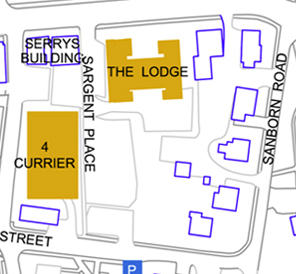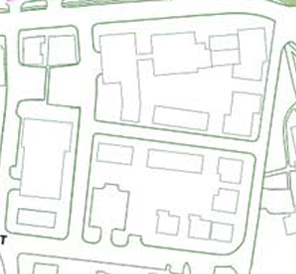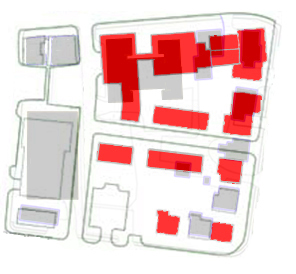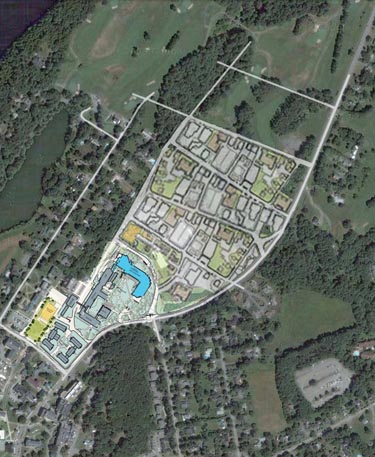-
Mayor + Kennedy Architects designed a large rear addition with some novel elements for 23 South Main Street.
-
The Hanover Improvement Society (of Nugget fame) opened an ice cream shop in the former Morano Gelato on South Main Street last year (John Lippman, “Bottom Line: Nonprofit answers Hanover’s screams for ice cream,” Valley News (20 June 2020)).
-
The League of New Hampshire Craftsmen closed the gallery it maintained in a notable Modernist building on Lebanon Street in the summer of 2020 (Valley News (30 June 2020)).
-
In the summer of 2020, the college ended the lease of the Jewel of India Restaurant on its late Victorian frame house on Lebanon Street (see John Lippman, “Dartmouth College won’t renew lease for Jewel of India restaurant in June,” Valley News (24 January 2020); Emily Lu, “Jewel of India relocates and reopens for takeout on July 15,” The Dartmouth (10 July 2020)).
See also background information on Sargent Block at this site; the one-time college master plan for Sargent Block; and Lisa Prevost, “Colleges Invest So ‘What’s the Town Like?’ Gets an Upbeat Answer,” New York Times (25 February 2020).
Category Archives: South Block
250th anniversary planning heats up
-
One might be surprised at paucity of info out there on the demolition of a part of the Hood Museum and the construction of a large addition. The D has a demolition photo from the Green taken last fall. Curbed.com has a post with two post-demolition photos. (See also the set of fascinating photos of the architectural model at Radii Inc.)
-
Metropolis does have a story on the Hood. These are excerpts:
Dartmouth first began seriously mulling over the Hood’s fate in 2001, when it commissioned a speculative study by Rogers Marvel Architects. In 2005, it commissioned another by Machado Silvetti, the architectural firm that designed the Hood’s newest neighbor, the Black Family Visual Arts Center. Then in 2010, it commissioned yet another study, this time by Centerbrook, the practice that Charles Moore cofounded afterparticipatory process, which put users on a level playing field Moore Grover Harper. None created the visual presence — that new front door — that Dartmouth administrators were looking for.
The college began soliciting proposals from a broader pool of architects. A selection committee, including faculty and administrators, winnowed down a short list. In the end, four architects were selected to be interviewed. John Scherding, director of campus design and construction, vividly remembers the TWBTA proposal:
“All of us in the room felt it was brilliant. They were the only firm that suggested disconnecting the Hood from Wilson Hall, allowing Wilson to stand proudly on the corner of the Green. They were the only firm that showed a strong identifiable front entrance to the building, infilled the courtyard to provide program space, and really strengthened the north-south axis. It was a very powerful and simple concept that satisfied all of the needs.”It thoughtfully preserves the gallery spaces (one exemplary detail: To preserve the windows along the staircase, and the dance of light along the walls, TWBTA will convert some of the windows into light boxes of stained glass) and will likely improve the museum experience in many fundamental ways.
-
The sestercentennial celebration website is up. The wordmark makes some interesting typeface choices. The unique “250,” which is set in a type that might be based on Bodoni, includes the most arresting element: a numeral “2” whose diagonal (neck?) is partially erased. The numeral “5” is partially hidden by the “2,” but there is no explanation for the missing bit of the “2.” Is it meant to look like the imperfect printing of an eighteenth-century pamphlet? It looks a bit like a stencil. In any case, the “Dartmouth” on the second line is set in the official Bembo (standard Bembo, not the Yale-only version), and the third line (“1769-2019”) is set in a sans serif font.
-
The sestercentennial will involve a year-long program of events (President’s message) created by a planning committee seeking to meet a number of goals.
-
Here’s a clever little film about an interesting story: Goudy & Syracuse: The Tale of a Typeface Found.
-
Interesting insignia decisions here: the midcentury Institute of International Studies in California was acquired a few years ago by Middlebury College (Wikipedia). In 2015, Middlebury “introduced a brand identity system that embraces the full breadth of its educational endeavors by placing the Middlebury name on each of its schools and programs” (MIIS page). And what a varied collection of institutions it is, including summer schools, conferences, and academic programs. The unified identity is based on a shield. I don’t know about the Midd shield: the globe looks like it’s from a different design language, from a 1960s U.N. brochure. The chapel touches the top of the shield. The hills, because they meet the edges of the shield, read as the sleeves of a gown or as curtains. Maybe this is because the eaves of the chapel are shown as angled bars floating free on the clouds.
-
The Institute is the only Middlebury institution that gets a truly distinctive shield, a variation “that replaces the Green Mountains of Vermont and Old Chapel with the historic Segal Building from the Monterey campus and the year of the Institute’s founding” (MIIS page).
-
A Kickstarter project for Design Canada, “The first documentary chronicling the history of Canadian graphic design and how it shaped a nation and its people.”
-
The New Yorker has has an article on lines of desire. Speaking of unplanned paths, the aerial photo of the vacated pipeline protest camp in the New York Times is remarkable.
-
McGraw Bagnoli Architects have published a brochure about the firm that details the five urban design projects planned by William Rawn Associates during the early 2000s. This is fascinating. It will be interesting to see whether the school ever completes the Sargent Block project and what plan it follows.
-
Smith & Vansant have photos of some of the houses the firm has renovated for the college, including Unity House and Thayer Lodge, both on South Park Street, 26 East Wheelock, 19 South Park, and the Victorian professor’s house of the North Park House community.
-
Architect Vital Albuquerque (again, great name) < ahref="http://rwu.edu/academics/schools-colleges/saahp/portfolios/alumni/vital-albuquerque-class-01">presents more unreleased renderings of the unbuilt NCAC, including a remarkable photo of a model of the project.
-
Engelberth Construction has its page for the West Stand Replacement up.
-
At the last board meeting,
Hanlon outlined goals to renovate a number of aging buildings, and the board approved funds to proceed with a schematic design for the renovation of Dana Hall, the former home of the biomedical library located at the north end of campus, to facilitate the expansion and improvement of faculty office spaces.
The board also approved a capital budget of $30 million to fund a number of projects, including the Morton Hall renovation and planning and feasibility studies of the abatement and demolition of Gilman Hall; renovations to Reed Hall and Thornton Hall; and undergraduate housing expansion and renewal.
-
A Moosilauke update with photos by Eli Burakian. The building has an interesting mix of construction techniques. Some of those “character” timbers are fantastic.
-
Some of the photos of the federal building that houses the Ninth Circuit Court of Appeals, such as the one in this New York Times story from February 9, show the elaborate metal lanterns flanking the entrance of the 1905 building. The lanterns might be familiar: architect James Knox Taylor, then Supervising Architect of the Treasury, modeled them on the torch-holders of Palazzo Strozzi in Florence of 1489 (GSA page on the Browning U.S. Court of Appeals Building). The Strozzi torch-holders also inspired Charles Rich in his design for Parkhurst Hall (1913).
-
Drove past Nervi’s SCOPE arena in Norfolk, Va. (1971-72) last weekend and admired the ribs that form the roof of this entrance pavilion (Google Street View):
Names that change, or don’t change; various topics
-
The Food Co-Op is in the second phase of its renovation.
-
The Rauner Library Blog has two posts (one, two) on a big scrapbook created by Francis Gilman Blake of the Class of 1908.
-
The Mirror (of The D) is doing a series of photos and descriptions of campus buildings, with some info drawn from the book.
-
A neat database gives information on all the memorials in London.
-
Old news: DCHCDS is being folded into DIHPCP (Valley News). The number of logotypes in the row (post) is reduced by one.
-
The Valley News reported that the Town is considering the creation of an affordable housing development.
-
The Trumbull-Nelson Newsletter (pdf) has an interesting history of the company, basically the Builders to the College, by Frank Barrett.
-
Brian Schott wrote a neat essay in the DAM about a wall painting in one of the East South Street houses demolished for South Block (pdf).
-
Long-time Valley News sports editor Don Mahler wrote that the one sports-related letter to the editor that made him laugh was a 1983 letter
from a Dartmouth alum taking “newcomers to the Dartmouth scene” to task over the use of the term “homecoming.”
According to the writer, “some clod started using the word just a few years ago.”“(A) large percentage of the Dartmouth alumni body, certainly prior to 1970 or thereabouts, never heard the word and when they do they associate it with cow colleges.”
“Cow colleges”? I guess he meant those colleges with alphabet monikers like A&T, A&M and A&I — you know, institutions of lower learning, never to be confused with the Ivy League.He declared Dartmouth Night to be a great tradition that was being undermined by the increasing use of the word “homecoming.” And he also lamented that “fall houseparties” were gradually slipping from usage.
Our correspondent revealed his true blue-blood colors in the last paragraph: “I may go down swinging on this, but I’m going to keep standing at the plate. … I’d rather work hard at teaching a clod a touch of class than let a drift to a common denominator prevail.”
Thirty-one years later, we know that the old boy did go down, not just swinging but presumably with a stiff upper lip. These days, the Dartmouth alumni relations office puts out an annual calendar of events that includes a celebration of homecoming. I can’t recall anybody objecting to the bovine vulgarity of the event in recent years.Of course that alum was hyper-obnoxious, especially since he was directing his complaint at the VN, which can describe Dartmouth events using any terms it wants. But buried in the pointless snobbishness is an historical observation: the event known as “Homecoming” was not always called that. The college called it Dartmouth Night Weekend until recently. (It must be acknowledged that both Alumni Relations and the Registrar now call it Homecoming.)
-
The Rauner Blog has a post on some Wheelock documents.
-
The Valley News did a story and graphic on the history of the Dartmouth football uniform.
-
Beyer Blinder Belle has posted a new, larger depiction of the firm’s master plan for the college campus. Wow.
-
The Geisel magazine has an article on the Williamson.
-
Sometimes King’s College London is pointed to as evidence in the argument that Dartmouth need not drop the word “college” from its name. Recently, however, KCL took up a rebranding plan (Inside Higher Ed, Roar News story on proposed logo). The reason to change the name to King’s London, as quoted in the Times Higher Education, echoed concerns heard at Dartmouth:
“However, our research conducted over the last 18 months with potential students, parents, staff, students and alumni, revealed that our current name was causing considerable confusion: is King’s a residential college, is it an academic college akin to the colleges of Oxbridge, or is it an educational institution of some other type such as a further education college?
“Internationally, there was further misunderstanding because ‘college’ is not a widely understood term in many countries,” he added.The article in THE doesn’t actually say which of those three types of institutions KCL is, and the institution seems not to be any of them. Although it is one of two original colleges in the University of London, making it like an Oxbridge college, it is now a research university divided among nine schools of its own.
In any case, the plan was controversial and was scrapped not very long after it was proposed (THE).
Sargent Block master plan revealed
I. Background. Dartmouth acquired most of the properties within two substantial blocks of downtown Hanover during the late 1990s. In the more distant block, called South Block, the Real Estate Office demolished most of the buildings and created a fairly intricate series of mixed-use replacements following a master plan by Truex Cullins. A below-grade parking deck fills the center of the block. The result is impressive: in the image below, the two commercial buildings north of the square white roof anchor the project, and the new buildings continue eastward along the street at the top of the image (South Street).
II. Phase Two. The projected second phase of the project will address the Sargent Block, along Lebanon Street. Located diagonally opposite South Block, this block is much closer to the center of campus. It includes the Lodge, an old motel converted to a dormitory decades ago.

This part of the project has been slow to get off the ground. C.J. Hughes reported in a 2010 Alumni Magazine article on the Lodge that the Sargent Block redevelopment has been put off until at least 2015. Dartmouth has built only one building in the block, 4 Currier Place, which architects Truex Cullins describe as “the first phase of the master plan for the Sargent Block redevelopment.” An old planning document (pdf) suggests that the redevelopment would replace 22 dwelling units on the site (rental units, not dormitory beds) and add an additional 113 units. Dartmouth has not released any information about a potential master plan for the block.
III. The Master Plan. A campus tour map posted on the Admissions website as late as August of 2010 included the then-current master plan for the Sargent Block:

Here is the master plan layered atop the existing conditions:

The master plan has probably changed since it was (somewhat inadvertently) published, but at the time, it seems to have been accurate. The map shows a number of interesting moves by Dartmouth.
The college is buying into the proposal in the town’s 2000 master plan that this block be divided by a new east-west street. In addition, the existing but somewhat vestigial Sargent Place is continued through the block. Both of these changes will improve circulation and make the closing of the north end of Sanborn Road an easier proposition.
The map indicates:
- The removal of three or four historic houses;
- The construction or relocation of two houses and one large addition;
- The construction of at least two large commercial buildings and six smaller ones; and
- The construction (apparently) of an underground parking garage.
The plan appears to retain the C&A Pizza building. The old frame house and its commercial addition add a lot of character to the street; the website says that C&A has been going since 1976, and that could be the date of the addition.
East of Sargent Place, the Lodge is to be demolished, of course. This will move the effective southern boundary of the campus to the other side of Lebanon Street and make Topliff the school’s southernmost dormitory — a big step. Also to be removed, at least according to the master plan, are the Victorian frame house of the Jewel of India and the solid brick house containing Kleen.
The Jewel of India really must be removed from its crucial corner site. It also really should be preserved, and its frame construction would make it relatively easy to relocate to a site in the southern part of the block. The appealing Kleen building is so substantial that it would seem a waste not to incorporate it into the redevelopment. But it is not a rarity in Hanover, so it might be hard to argue for.
Around the corner onto Sanborn Road, the plan shows the removal of two frame houses. Below the new cross-street, the two existing houses are preserved, one with an addition to bring it out to the corner — nice. This southeastern corner of the block is depicted as preserving the residential character of the immediate area, however small that area is.
IV. Conclusion.The plan only hints at the buildings that might someday form a new gateway to Dartmouth. But it is a positive sign.
———
[Update 08.12.2012:
Something about the plan rang a bell: This presentation (pdf), linked here during 2008, has a more detailed version of the plan and even a few perspective renderings. The first rendering shows the intersection of Lebanon and Sargent Place looking south. That’s the Serry’s Building on the right and the Lodge replacement on the left. Compare this view:
Walking down Sargent Place to the new corner and turning left would reveal the second view included in the presentation. The third image is hard to place but might be a view to the south along Sanborn Road or west along South Street.
What about the plan as a whole? It seems quite appealing. It is hard to believe that a ratty parking lot could be turned into this neighborhood. Replacing a dormitory (the Lodge) with rental housing and commercial buildings amounts to an unusual retreat for the college, a constriction of the borders of the campus. At the same time, the plan is not meant to rule the outcome: the flat roofs and streaky-bacon brickwork will not emerge precisely as they are depicted. For an example, compare the semi-Modernist reality of 4 Currier with the gabled prediction of the early views.]
—–
[Update 05.03.2014: Broken link to 4 Currier page replaced.]
[Update 11.17.2012: Broken link to old planning document fixed.]
DADA Exhibition at 4 Currier starting Saturday
A new group called DADA – Dartmouth Alumni in Design and Architecture has formed, and it’s holding an exhibition of work by alums from June 11 through June 19.

(Via Sue.)
The coat of arms on a pair of shoes, and other items
- New Balance has put Dartmouth’s current midcentury coat of arms on the tongue of a pair of shoes in its Ivy League Collection (via the Big Green Alert Blog; there’s a post on The Dartmouth‘s blog).
- Rauner’s blog has notable items on Cane Rush, Foley House, “the Glutton’s Spoon,” and the practice of “horning.”
- The Valley News has an article on the renovation of the 1890 Wilder Church. The church had a lot of Dartmouth associations early on and is another benefaction of Charles T. Wilder, donor of Dartmouth’s physics lab.
- Plan N.H. is the state’s “smart growth” group, and it gave a 2009 Merit Award to the South Block project.
- There is a photo of the Zantop Memorial Garden in Dartmouth’s Flickr photostream (story in The Dartmouth, dedication program). It looks like the garden finally resolves the former awkwardness of the slope in front of Richardson Hall: never a proper stone-walled terrace, but too extreme to plant with grass and try to ignore.
- The last remnant of Campion’s various long-lived stores on Main Street closed last fall (The Dartmouth, Valley News).
- The Dartmouth reports that the [flower-] painted panels in the ceiling of Thayer’s main dining room contained asbestos and are being removed.
—–
[Update 05.03.2014: Broken links to PlanNH pages replaced.]
[Update 01.05.2013: Broken link to The Dartmouth repaired, broken link to The Dartmouth‘s blog removed.]
[Update 01.22.2011: Links to shoe and horning articles added.]
South Street Hotel to open
The Dartmouth Institute of Health Care Delivery Science
A Valley News article reports President Kim’s suggestion that Dartmouth host a national institute of the science of the delivery of health care. One imagines that it would accompany or expand upon the existing Dartmouth Institute for Health Policy and Clinical Practice. That institute is scheduled to occupy the postponed future Koop Medical Science Complex at the south end of the Dartmouth-Hitchcock Medical Center (map).
If not located at the hospital, however, such an institute would make an excellent candidate for placement north of the medical school, even on the golf course. It would not require parking for patients; it would benefit from its proximity to downtown — walkable if not convenient enough for a student function — and yet it would be indisputably part of the college.
To allay the concerns expressed here last year, this building and any other buildings on the site should be made to follow the form of the town, not the campus. A grid of streets with sidewalks and buildings, rather than a network of curving driveways with lawns, would promote density while acknowledging that the college does not expect students to walk this far from the Green on a regular basis. The buildings would harmonize with the campus without pretending to be a part of it — much more South Block than McLaughlin Cluster.
The Institute for Security, Technology, and Society could move to the site, along with other administrative offices now at remote locations, such as the offices in the bank building on Main Street and the Development Office, which is in Centerra.
The perfect completion of such a plan would involve the Hanover Country Club House. The club has wanted a larger and more convenient clubhouse for several years. A new east-west connector street at the north end of this expansion project, crossing the south end of the golf course between Lyme Road to Rope Ferry Road, could provide an excellent site for such a building. The clubhouse would occupy the north side of this street, looking up the stretch of greensward; the south side of the street would be a densely-built wall representing the end of the urban development of Hanover. Compare the fascinating conditions of the Royal and Ancient Golf Club of St. Andrews.
In Hanover, the clubhouse would stand on the north side of the northern cross-street, whichever was built:

Example of town-form development
—–
[Update 05.03.2014: Broken link to DIHP&CP facts and figures replaced.]
[Update 09.25.2010: With all this talk of buildings, it never occurred to me that the Dartmouth Center for Health Care Delivery Science would be mostly on-line.]
[Update 02.06.2010: Map added.]
4 Currier and its metal-clad top level
The office building at 4 Currier Place, designed by Truex Cullins (project page) for the Dartmouth Real Estate office (rental page) is nearing completion. Guy C. Denechaud’s article in the Valley Business Journal notes that Dartmouth has not put this much office space on the market in years.
—–
[Update 11.17.2012: Broken link to rental page removed.]
[Update 08.31.2013: Broken link to project page replaced.]
South Block observations
The Valley News article on President Wright’s retirement focuses on the South Block project as the most substantial sign of the College’s influence on the Town, and notes its success. The article also mentions that President Emeritus Wright will have an office in South Block.
Hotel at South and Main delayed
The Dartmouth reports that Olympia’s planned “boutique” hotel will not be built but that the project has been handed off to another developer.
South Block redevelopment finished
The Dartmouth reports on the completion of this large project, and Willy Black comments positively in the CV Spectator.
Construction on the hotel going in south of the Post Office (north of Umpleby’s on South Street) will begin in 2009. The building will have an underground garage.
—–
[Update 03.31.2013: Broken link to Olympia hotel info removed.]
South Block and the neighborhood
Dartmouth’s Real Estate Office is finishing 68 South Main, the most prominent building in the South Block project. Its neighbor, the frame building in the drawing, is number 72.
The latest rendering of the hotel planned for South Street is an improvement over the plainer, more prefab first version.
“The Chimneys,” Ledyard Bank’s building at 2 Maple Street, is finished.
—–
[Update 01.13.2013: Broken link to Olympic Companies rendering removed.]
South Block redevelopment continues
The Valley News recently noted that Dartmouth’s real estate office is planning to build a commercial building on Currier Place, which marks the eastern edge of the South Block project.
In an article on an unrelated topic, The Dartmouth published a photo of 68-72 South Main Street, which is the largest commercial building in South Block. The western (Main Street) facade occupies the right side of the photo.
The Dartmouth has reported and provided a brief on a three-level, 72-room hotel planned to open on South Street around 2010. It is not clear whether this is the Currier Street project above, but it does not seem to be. Olympia Development has a rendering of the hotel.
—–
[Update 11.17.2012: Broken link to Olympia removed.]
[Update 07.16.2008: These are two different projects. The Dartmouth Real Estate Office is building a commercial building at 4 Currier Street, diagonally opposite the northeast corner of the South Block.]
General construction update
In general construction news, Guy C. Denechaud writes that “Projects Are Plentiful at Dartmouth College,” Valley Business Journal (April 7, 2008).
The Valley News reports that the fieldhouse at Burnham, called the Sports Pavilion, is open as the clubhouse for the soccer and lacrosse teams. The school will add an athletic trainers’ facility to the north side of the building in the future.
Alpha Theta is also working on repairs to comply with the Fuller Audit.
The Dartmouth reports that Bartlett Hall is being rehabilitated.
New Hampshire Hall’s exterior was photographed prior to the expansions that is under way now.
South Block redevelopment winding up
Vox notes that South Block will be completed this summer and has an updated perspective sketch of the corner building that will occupy the site of Big Green Cuts and Ramunto’s. Amazingly, seventy people will live within the block, which must be a dramatic increase from the population before the redevelopment.
“The Chimneys” rising behind gas station
The part of Hanover’s downtown that lies below South Street is changing rapidly.
A commercial building called The Chimneys (Randall T. Mudge & Associates, 2006-07) is being built at 2 Maple Street, behind the service station on South Main Street. Guy C. Denechaud wrote in an article in Valley Business Journal (April 6, 2007) that the main tenant of the three-level building will be the Ledyard National Bank‘s
investment offices. The building should open in December. (Thanks, Tim, for the information.)
Gates House details to be salvaged
It turns out the historic Gates House is gone, although some of its elements will be applied to a recreation near its site, designed by U.K. Architects.
The article in The Dartmouth on South Block progress points out that only parts of the building will be saved.
The bakery that will move into the building, Umpleby’s, is blogging about the construction and has posted photographs of the empty building site and the rear of the original house before dismantling; the ground-level framing of the replacement; the framing of the walls to the roofline; the completion of the basic form (it really follows the form of the original); and the completed building covered in Tyvek.
—–
[Update 11.13.2012: Five broken link to Umpleby’s blog removed.]